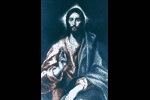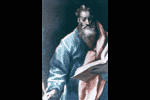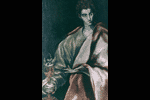"El Greco's art is a strong
personal blending of Late Byzantine and Late Italian
Mannerist elements. The intense emotionalism of his
paintings, which naturally appealed to the pious fervor of
the Spanish, the dematerialization of form, and a great
reliance on color bound him to ...
Mannerism.
His strong sense of movement and use of light, however,
prefigured the Baroque style."
- Gardner's
Art Through The Ages,
11th edition, Vol. II, p. 717
Christ: The Saviour

Saint Matthew the Evangelist

Saint Luke the Evangelist

Saint John the Evangelist

***** insert image of
Saint Peter *****
***** insert 2 images of the Assumption of the Virgin
*****
***** insert
image of The Burial of Count Orgaz *****
"El Greco's art was not strictly Spanish (although it
appealed to certain sectors of that society), for it had no
Spanish antecedents and little effect on later Spanish
painters. Nevertheless, El Greco's hybrid style
captured the fervor of Spanish Catholicism. This
statement is especially true of the artist's masterpiece The
Burial of Count Orgaz, painted in 1586 for the church of
Santo Tome in Toledo. El Greco based the artwork on
the legend that the count of Orgaz, who had died some three
centuries before and who had been a great benefactor of
Santo Tome, was buried in the church by Saints Stephen and
Augustine, who miraculously descended from heaven to lower
the body into the sepulcher.
"In
the painting, the brilliant Heaven that opens above
irradiates the earthly scene; El Greco carefully
distinguished the terrestrial and celestial spheres.
He represented the terrestrial with a firm realism, while he
depicted the celestial, in his quite personal manner, with
elongated undulating figures, fluttering draperies, and a
visionary swirling cloud. Below, the two saints
lovingly lower the count's armor-clad body... [while] a
solemn chorus of black-clad Spanish personages fills the
background. ... These men call to mind the conquistadores,
who, earlier in the century, ventured to the New World and
who, two years after the completion of this picture, led the
Great Armada against both Protestant England and the
Netherlands.
"... El Greco's deliberate change in style to distinguish
between the two levels of reality gives viewers the
opportunity to see the artist's early and late manners in
the same work, one below the other. His relatively
sumptuous and realistic presentation of the earthly sphere
is still strongly rooted in Venetian art, but the
abstractions and distortions El Greco used to show the
immaterial nature of the Heavenly realm characterized his
later style. ... Although he used Mannerist formal devices,
El Greco's primary concerns were emotion and expressing his
religious fervor or arousing that of observers. To
make the inner meaning of his paintings forceful, he
developed a highly personal style so that his tapering
forms, swaddled in dynamic swirls of unearthly light and
color, appear as spiritual visions."
- Gardner's
Art Through The Ages,
11th edition, Vol. II, p. 717
|